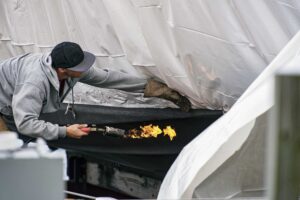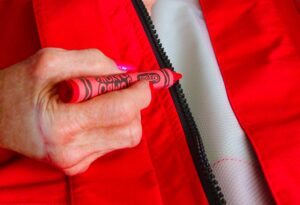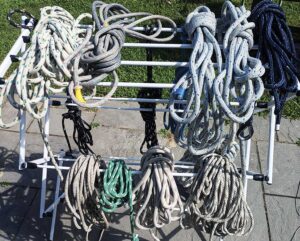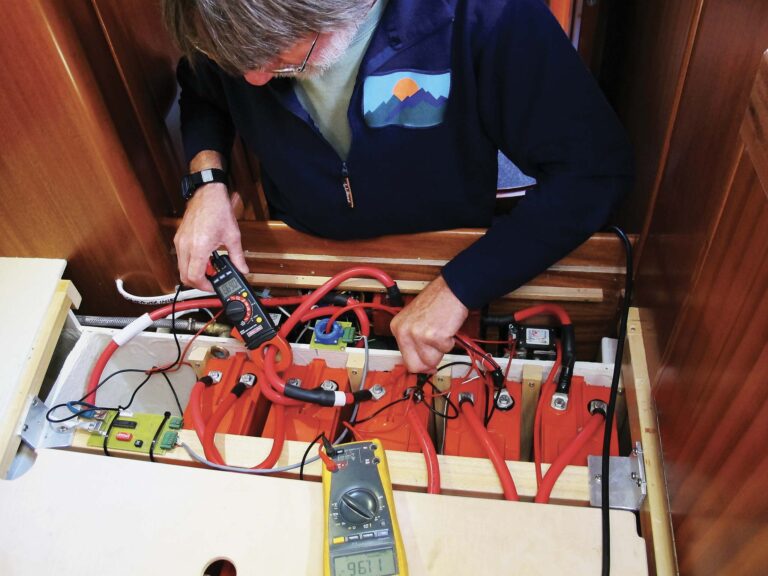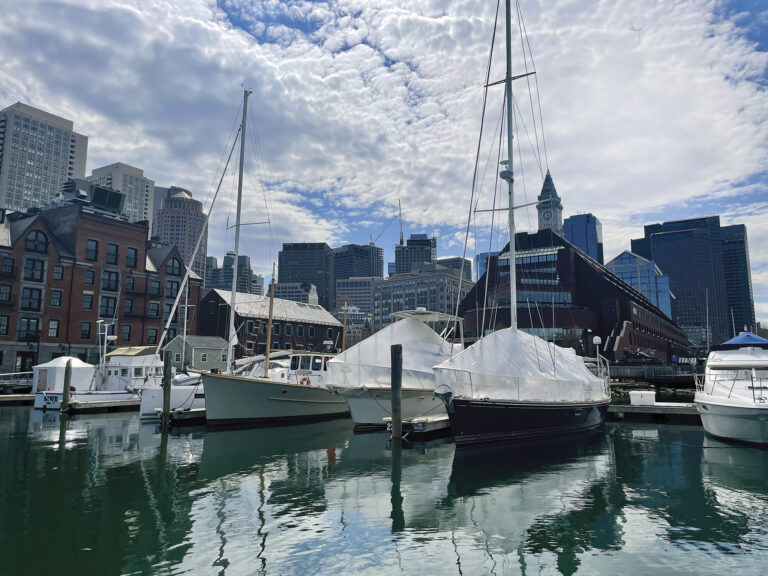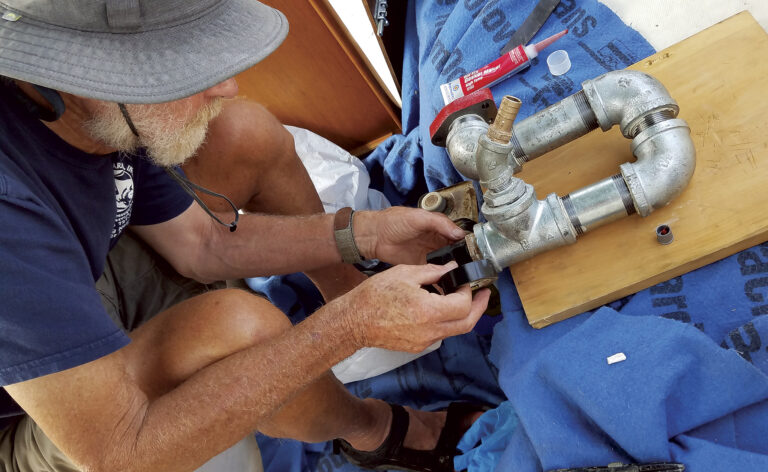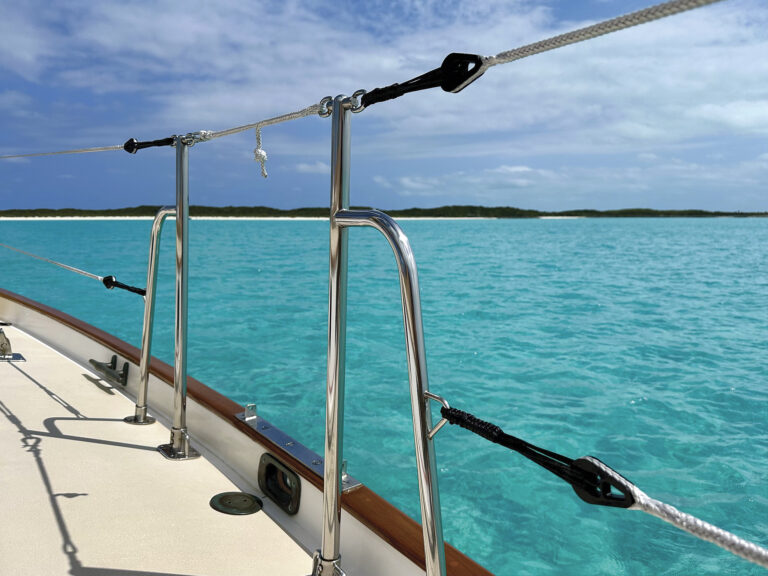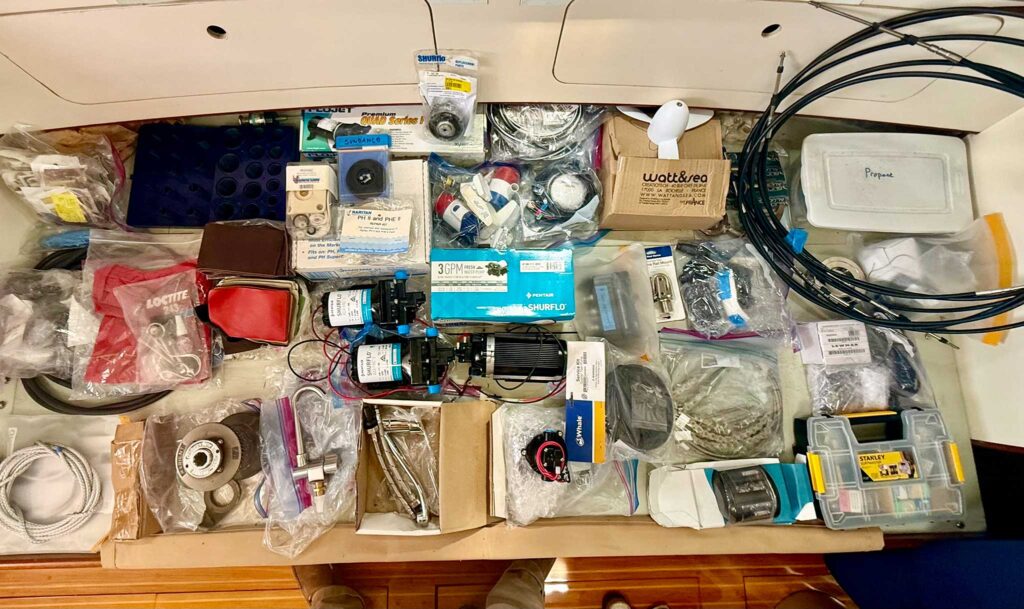A good onboard inventory of spare parts is a treasure chest. It’s like having your own custom-built marine store at arm’s reach at all times. Spare parts make crucial repairs possible and are essential equipment to carry. Experienced sailors cherish their spares and will happily make space for them aboard at the cost of room for other important things like surplus food and extra crew. You’re going to need most everything on the spares list eventually, so the expense is justifiable. Wisely purchasing ahead is good seamanship.
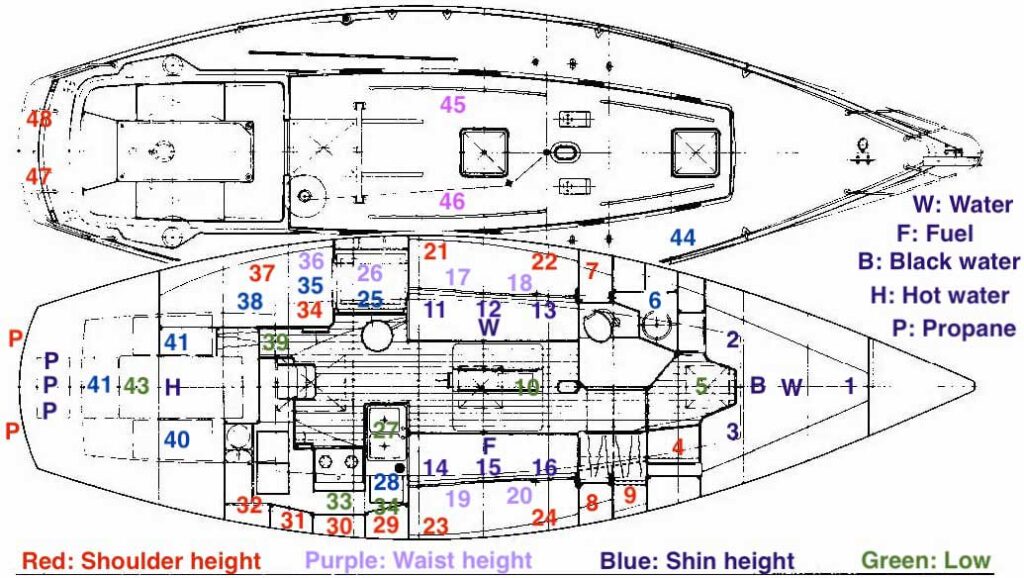
Spare parts lists should be customized to match the boat.
The list below serves as a good generic starting point:
Recommended Spare Parts Inventory
Numbers refer to storage location on the boat storage map.
In no particular order, because you never know which spare you’ll need next.
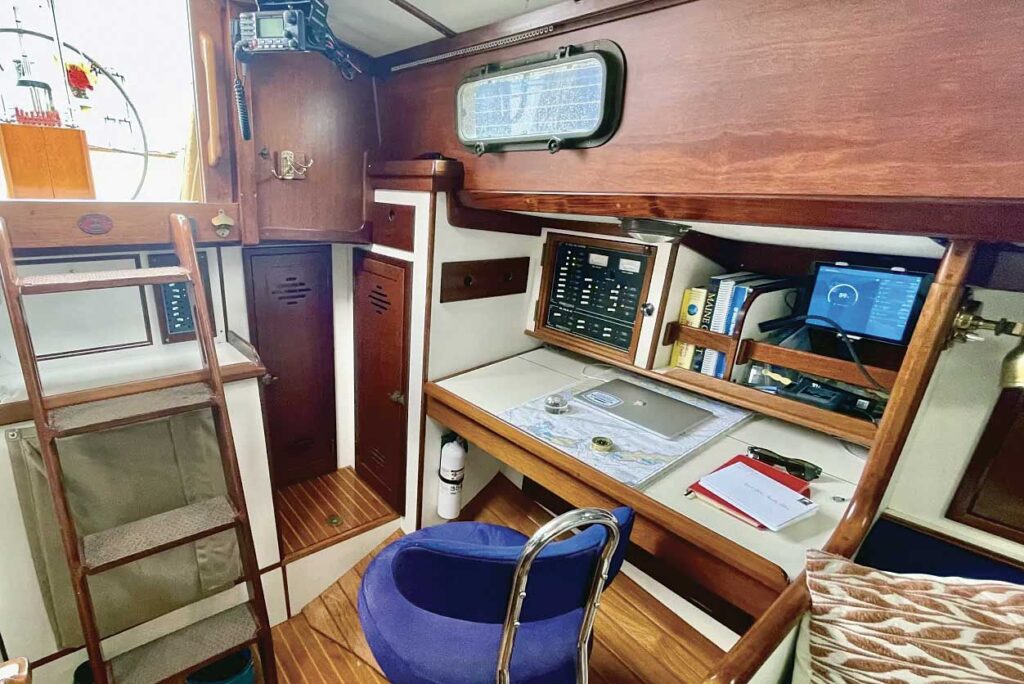
Spare plumbing parts:
• Electric bilge pumps – 12
• Electric bilge pump float switches – 12
• Manual bilge pump – S&M
• Manual bilge pump service kit – 13
• Electric freshwater pump – 13
• Freshwater and saltwater foot pumps – 7
• Saltwater washdown pump – 12
• Saltwater washdown hose quick disconnect fitting – 11
• Toilet rebuild kit – 7
• Toilet pump – complete – 7
• Toilet pump handle – 7
• Toilet holding tank macerator pump – S&M
• Water heater heating element and thermostat – N/A
• Watermaker service kit – 16
• Watermaker filters – 16
• Watermaker pressure pumps – 16
• Replacement seacock handle – N/A
• Assorted stainless hose clamps of relevant sizes – 12
• Miscellaneous rubber O-ring kit – 11
• Assorted lengths of relevant hose – 41
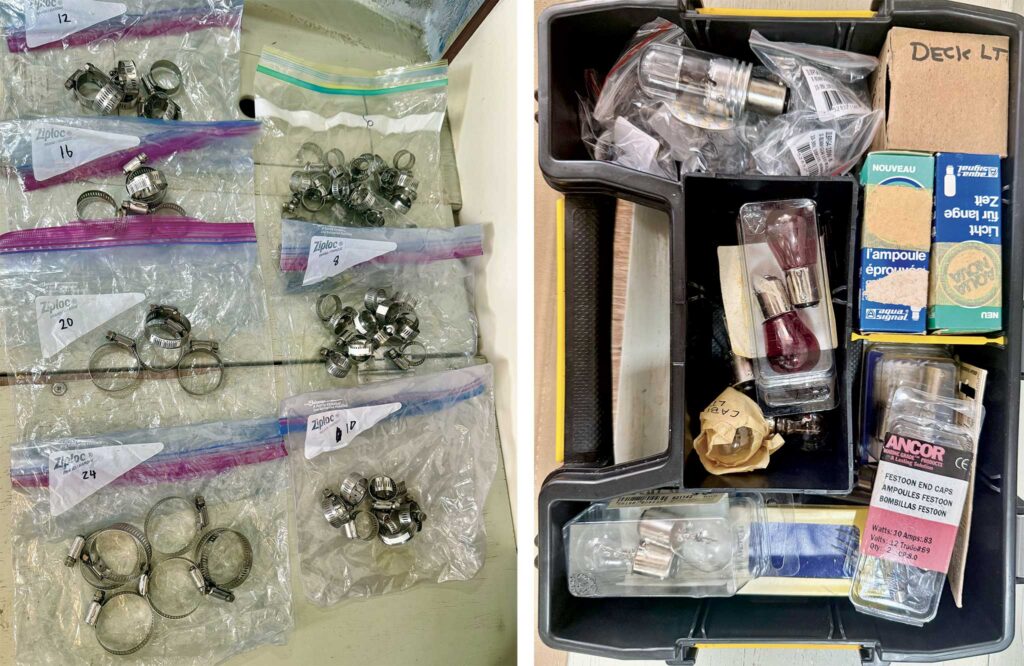
Spare engine parts:
• Propeller – S&M
• Starter motor – S&M
• Alternator – S&M
• 3x raw water pump impeller and gasket – 25
• Raw water pump – complete – 25
• Shift cable – 15
• Throttle cable – 15
• Replacement electric stop solenoid – NA
• Belts – 25
• Replacement dripless packing lip-seal – 25
• Replacement stuffing box flax packing – N/A
• 3x engine oil filters – 25
• 6x engine primary fuel filters – 25
• 6x engine secondary fuel filters – 25
• Engine oil. (Enough for two changes.) – 40
• Transmission oil. (Enough for two changes.) – 40
• Engine coolant. (Enough for two changes.) – 40
• Engine oil change pump – S&M
• 6x sacrificial zinc anode set – 39
• Diesel fuel – 44
• Diesel fuel transfer pump – 11
Note: The generator, if you have one, requires most of the same spare parts as the engine. The dinghy motor, if you have one, requires many of the same spare parts as the engine. Twin-engine boats need not double up on all engine spares.
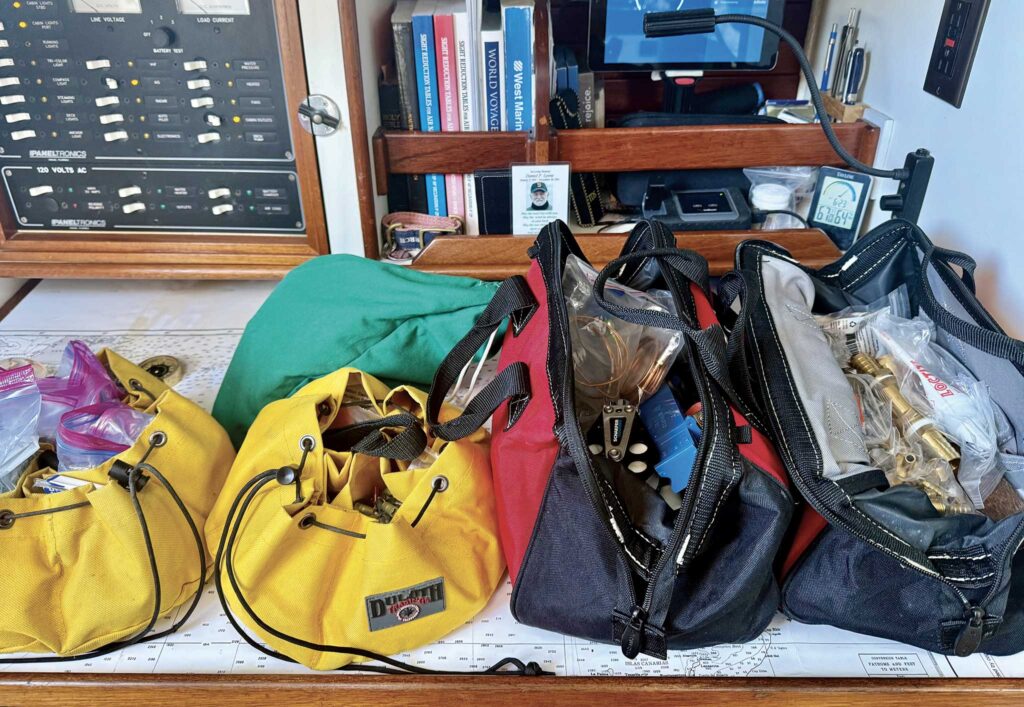
Spare electrical parts:
• Navigational electronics:
• Autopilot – 43
• Chartplotter/MFD – S&M
• Cartography chips for above – S&M
• GPS antenna – S&M
• Depth/speed/wind display – S&M
• Depth/speed/wind transducers – 5 and S&M
• VHF – S&M
• AIS – S&M
• VHF antenna – 36
• All network wiring components of the system – 13
• Handheld GPS – 35
• Handheld VHF – 35
• Solar and hydro-generator charge controllers -12
• Solar and hydro-generator system spares – 12
• Anchor windlass – complete with all associated parts – 1
• Propane solenoid – 12
• Propane regulator – 12
• Propane sniffer – 12
• Replacement light bulbs – 14
• Running lights – 13
• Replacement fuses – 37
• Replacement panel breakers – 37
• Miscellaneous lengths of relevant wire – 37
• Miscellaneous wire connectors and end fittings – 37
• Heat shrink tubing – 37
• Wire ties in various lengths – 37
• Phone/tablet/computer chargers – 25
• Phone /tablet/computer charging cords – 25
• Favorite phone apps on alternate devices
Miscellaneous spares:
• Steering system spare parts kit per manufacturer’s recommendation – 15
• Emergency tiller – 40
• Windvane steering system spares kit per manufacturer’s recommendation – 11
• Running rigging: all halyards, sheets, and control lines. – 41
• Emergency replacement stay. (Customizable dux is best for this job.) – S&M
• Blocks, shackles, cotter pins of relevant size and design – 14
• Deck plate cap compatible with fuel, water, and waste fills – N/A
• Deck plate cap O-ring for above – 11
• Deck plate key for above – 34
• Winch handle – 41
• Winch spare parts kit – 14
• Crucial tools – 34
• Miscellaneous stainless fasteners – 36
• Opening port gasket material and replacement hardware – 11
• Cooking stove/oven spare parts kit – 12
• Galley essentials – 33
• Dock lines – 41
• Chafe gear – 11
• Anchor chain snubber line hook – 14
• Oar locks – 13
• Oars – 46
• Reading glasses – 25
• Sunglasses – 25
• Miscellaneous disposable batteries – 26
• Fire (matches) – 26
• Drinking water (1 gal/crew/day) – 1
• Hat – 2
Yes, this is a long list. And no, not even I, its author, stock all of the above spares on my 36-foot cruising boat. In some cases, an item is not applicable to my boat, but I felt compelled to include it for the purposes of this general discussion. I’ve noted these items as “N/A” in the list above. (In some cases, “N/A” also stands for not available. The outcome is the same, so I didn’t bother with a different acronym.) The careful reader will also note that several items are listed as “S&M.” It’s not what you think! In this case, the acronym stands for “storage and money.” As in, if I had more storage space and/or more money, I would add this item to my spare parts inventory because I think it is worthy of inclusion. As is the case with all dogma, use your best judgment when you work out your own list for your own boat.
Smart Storage
With so many parts and supplies stowed on a boat, it can be hard to find the part you need when you need it without some well-thought-out organization. Maintaining a storage map for your boat will help you lay hands on parts when needed. A checklist of parts will help with inventory. The numbers following the parts on the list above indicate the location on the storage map for my boat.
Some practical logic is worth considering when thinking about spares. Opting to stow a spare part near where it will ultimately be put into service is smart storage. Triple-plastic-bagging is smart storage. Stowing heavy things low and amidships is smart storage and good seamanship. Soft-sided storage bags, especially parachute bags, deliver both compact and flexible packing that tends to maximize the use of unusually shaped storage spaces.
For ease of installation, spare parts should be identical to the parts currently in service aboard the boat. When you use a spare, don’t forget to replace it in the inventory at the next convenient and cost-effective opportunity. For installation of most spare parts, you will need tools. Oftentimes, sealants, adhesives, and lubricants will also be required. We’ll save the review of those supply lists for another discussion.
Obsolescence
Obsolescence provides a compelling argument for stocking spares. Nowhere is that more true than in the quickly evolving world of marine electronics. New equipment on your boat today is likely to be outdated in three years, and many replacement parts may no longer be available then. Likewise, a replacement component purchased three years from now is not likely to be compatible with the rest of the networked system you currently have installed aboard.
I was recently tasked with repairing an autopilot system on a sailboat. Troubleshooting led me to conclude that the box containing the central computing brain in the system had failed beyond repair. That component, although only a few years old, was obsolete and no longer available from the manufacturer or anywhere online, new or used. The updated replacement component from the manufacturer was not compatible with all the other older parts that plugged into it: the drive unit, compass, rudder angle indicator, and control head. The only solution was to replace the entire autopilot system. The new drive unit required engineering and construction of a new mount. The new generation of communication cable used by the new autopilot was incompatible with the networked chart plotter, necessitating the replacement of that screen as well. Once renewed, the chart plotter was no longer compatible with the existing radar or the wind, speed, and depth instruments. At the end of the project, the VHF radio was the only component in that boat’s electronics system that didn’t demand renewal as this project snowballed. (But it did require a software update.) None of the electronics on this boat were exceptionally old, but to maintain full functionality, I needed to replace almost everything because of one failed component.
For compatibility’s sake, it’s wise to equip a boat with the same generation of electronics built by one manufacturer. When renewing a suite of electronics, it’s prudent to purchase spares for every component and every cable in the system. Spare electronics are also excellent to have on hand for troubleshooting tasks.
Marine electronics are expensive, but installation engineering, wiring, and installation labor is considerably more costly. Opportunity costs associated with a mid-season breakdown are the highest of all. If you conclude that you need a piece of electronic equipment on board, then you need spares for all components in the networked system.
In today’s age, phone apps are ever more relevant onboard, and as such, ever more worthy of backing up with a spare. The prudent mariner will load all favorite weather, navigation, satellite phone, cruising guides, and other relevant apps, complete with subscriptions as needed, onto another device aboard, such as a tablet or a regular crew member’s phone. This way if the boat’s primary navigation phone is lost, stolen, or sunk, functionality aboard won’t skip a beat while waiting for that lost phone to be replaced.
Different spares for different ships
Sailors use their boats in different ways, and the onboard inventory of spare parts should be adjusted accordingly:
• The day-sailor’s need for spare parts is negligible, aside from a spare hat should one get lost over the side. This boat is always close to home, where parts should be relatively easily sourced as needed. Considerations for obsolescence is a noteworthy exception.
• The coastal cruiser is well advised to store a full complement of spare parts aboard. Having the right spare aboard to enable the timely repair of a crucial system while at sea is an important safety factor for the near-coastal boat. If you can limp into port with a broken gear, stocking spares is still a valuable practice. When a component fails during your mid-summer cruise, sourcing that part will become your first project, or your local mechanic’s first task. Inevitably, it will be a Friday afternoon, and your replacement part won’t arrive until Tuesday at the earliest. Having the spare part already aboard will save you a long delay and an expensive second trip to the boat for the mechanic, if you opt to hire one. Also, a planned purchase in advance, without express shipping, will be less expensive than rushing the part to the boat when it’s suddenly needed.
• The ocean-crossing boat must carry all her spare parts despite the competing demands for storage space aboard such a boat. Because self-sufficiency is mandatory in the middle of the ocean, the crew of this boat should possess the tools and knowledge required to install all the spare equipment. If the crew lacks the strength or skills to replace all the components of the boat’s systems while at sea, they needn’t give up their dream of crossing an ocean. Instead, they should opt to cross an ocean in a simpler boat.
• The captain of the near-coastal race boat, obsessed with minimizing weight, may take a “damn the torpedoes” attitude and opt to stow many of their spares on the shelf in the chandlery. The offshore race boat, on the other hand, should value self-sufficiency and carry most recommended spares aboard despite the weight.
When buying or selling a used boat, a proper inventory of spare parts should be expected as a part of the transaction. An inadequate supply of spares should be a red flag for any buyer and make them question where else the seller has cut corners in regard to boat care.
This story is an excerpt from SAIL Contributing Editor Christopher Birch’s upcoming book The Four Seasons of Boat Maintenance (available for order soon)—a compendium of lessons learned during his 40-year career maintaining other people’s boats as the founder and owner of Birch Marine Inc. in Boston. Chris and his wife, Alex, are now cruising full-time aboard their 36’ Morris Justine. Follow their voyage at eaglesevensailing.com.


